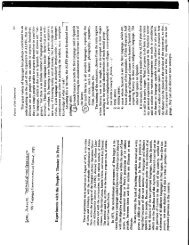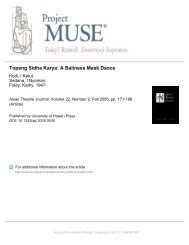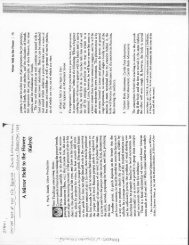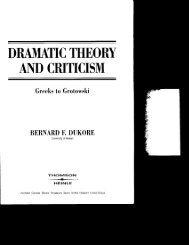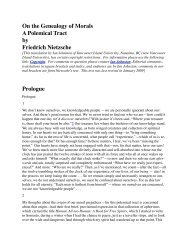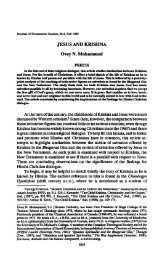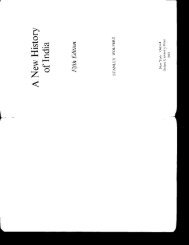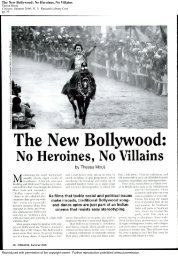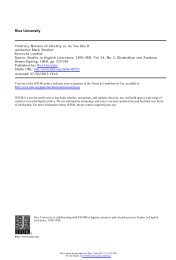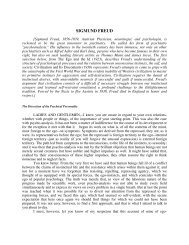Contemporary China - Yavanika
Contemporary China - Yavanika
Contemporary China - Yavanika
You also want an ePaper? Increase the reach of your titles
YUMPU automatically turns print PDFs into web optimized ePapers that Google loves.
divergent women as<br />
l contemporary Chinese<br />
toy's Anna Karenina. Pan<br />
;ed for its relevance to<br />
o Chinese society of the<br />
trivcxr. He was born at<br />
u Zonghai - an erudite<br />
:r whom he had his first-<br />
;ix. After apprenticeship<br />
jingxi master actors, he<br />
ned for the perfection of<br />
the young scholar-hero<br />
3g!1ar1y partnering Mrr<br />
rg professional career Yu<br />
tigably to preserve kunqu,<br />
ion of performers at the<br />
cademy of Dramatic Art<br />
'ork was disrupted by the<br />
He is an accomplished j<br />
I as.singer and actor, and l<br />
:y'l,i:::"'__ l<br />
leijingopera performance,<br />
maturgy and stagecraft.<br />
I the institution produced<br />
schools at all levels is<br />
itive examination: about 5<br />
rin admission. There is still<br />
fmales, the rationale being<br />
men.<br />
#omen tO sing female roles<br />
n 1951 Premier Zhou Enlai<br />
tor Zhang Chrinqiu: 'up to<br />
hat's the end'. If this po1iry<br />
omen will perform all dan<br />
hat a handful of female<br />
g trained, so the art may<br />
:rformers has risen greatly<br />
the reasons for this are the<br />
I discrimination which prer<br />
highly organized recruit-<br />
:m, an improved standard<br />
ofliving, and the govelnment's high evaluation of<br />
'att workers' as a profession. There arc, however,<br />
still strong gradations in the status ofpelformers:<br />
stars may be among the nost influential and<br />
respected members of society, while ordinary performers<br />
live in serious poverty and social disregard.<br />
Since the earliest days of its existencc thc CCP<br />
has strongly encouraged amateur artists who, it<br />
considered, could assist its propaganda work<br />
among the nasses to an extent even greater than<br />
professionals. The slogan pushed was 'snall in<br />
scale, rich in variety' (xiaoxing duoyang), neaning<br />
that long o[ courplicatcd picccs |equiring exteusive<br />
training or elaborate and expensive costLlmes<br />
should be avoided. The spoken drama, simple<br />
songs and dances, or balladry iterns, were greatly<br />
preferred to traditional music drana. The Cultural<br />
Revolution gave great priority to 'mass ilnateur<br />
propaganda tror.lpcs' and for several years in the<br />
late 1960s they were morc or less thc only soulce of<br />
<strong>China</strong>'s theatrical Iif'e.<br />
Since the late 1970s amateur troupes have<br />
declined markedly. To fill their place semiprofessional<br />
troupes have arisen everywhere in Cl'rina,<br />
especially in the countryside where fully plofessional<br />
theatre is less accessible than in the cities.<br />
Peasants fbrm troupes on their own initiative and<br />
only the tnost talented and skilled local performers<br />
are chosen. They spend most of the year as peasants,<br />
and during the slack season they go around<br />
performing, mainly traditional regional music<br />
dramas. The reward is financial, for although the<br />
performers do not receive salaries, they are paid<br />
out ofbox-office returns according to their coDtribution<br />
to the particular drama. Even if they perform<br />
in the street and there is no box-office, they<br />
are quite likely to be thrown tips from the audi<br />
ence. ln 1983 there were about 3000 seniprofessional<br />
troupes in the single province ofAnhui, and<br />
the number was still rising.<br />
Conclusion<br />
Clearly the peliod since 1978 has brought cnormous<br />
changes to the Chinese theatre in all<br />
respects. A major feature of society in general and<br />
the theatre in particular is a dichotomoris impulse<br />
towards modernization on the one hand and a traditionalist<br />
revival on the other. The najor thrust is<br />
still socialist in that content tends to reflect socialist<br />
society and nany fully professional ttoupes<br />
remain state-owned. However, despite a reversal<br />
fiom mid-1 989 to the beginning of 1 992 due to the<br />
1989 Tiananmen Square crisis, the overall direction<br />
of change since 1978 has been towards greater<br />
variefy and liberalisn in terms of form and content,<br />
and free enterprise in organization, with ideology<br />
reflecting nationalism more strongly than<br />
Marxisn-Leninism. Experience in other countries<br />
suggests that economic modernization affects traditional<br />
arts adversely. Despite the current enthusiasm<br />
in <strong>China</strong> for traditional music drana as an<br />
exanple of its national arts, the sane could easily<br />
happen there in the next few decades.<br />
Genres<br />
Chuaniu (Sichuan opera).<br />
The forn of music drama fbund in Sichuan,<br />
<strong>China</strong>'s most populous province, and one of the<br />
lnost important of the country's regional sfyles.lt<br />
grew out of five different musical and theatrical<br />
styles that originally were independent, four<br />
belonging to the main systems of Chinese theatre<br />
and introduced frorn outside the province. The<br />
earliest of these, gaoqiang, came into Sichuan<br />
around the 17th century. A variant of the 'musicoiYiyang'drana,<br />
it featured an offstage chorus.<br />
Slightly latcr, clapper opera, known in Sichuan as<br />
tanqianq, ('strum music'), was introduced from<br />
Shaanxi to the north. Next huqin qiang { 'music of<br />
the huqin t. a variant ol'the PTHUANG syslerrr, inlroduced<br />
the two-string huqin instrunent.<br />
Aristocratic 1{uNeuwas popular with the officials<br />
of Sichuan. The one fbrm native to Sichuan was<br />
dengxi ('lantern theatre'), a folk style based on<br />
local mask dances of village shamans.<br />
Early in the 20th century, the theatre was<br />
reforned and the five stylcs began to be perforned<br />
on the same stage and were regarded as a<br />
uniry, though every iten still retained its style of<br />
origin in its umsic. The first teahouse-theatres<br />
were introduced into Sichuan's cities. Probably<br />
the greatest of the refblners was Kang Zilin<br />
(1870-1931), a fine actor, teacher and leader of<br />
the famous Three Celebrations (Sanqing)<br />
Conpany (est. 1912). Apart from the decade ofthe<br />
Cnltural Revolution, Sichuan opera has flourished<br />
under the Comnunists, especially since<br />
1978. The Sichuan Province Chuanju Research<br />
'.,,tt.,<br />
51



